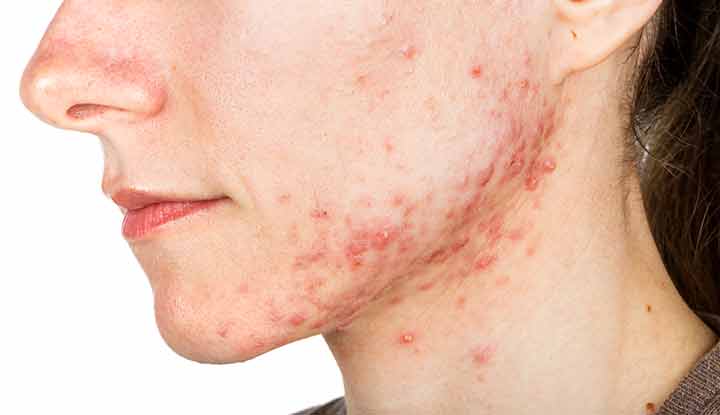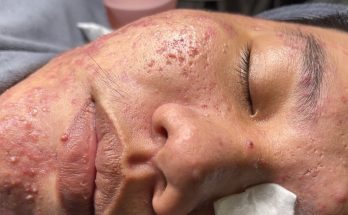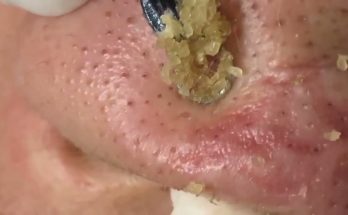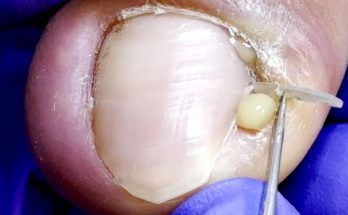Cystic Acne
People with cystic acne develop pus-filled acne cysts (pimples) deep under the skin. The acne cysts are often painful and can be large. A dermatologist should treat cystic acne to reduce the risk of scarring and infection. Antibiotics and prescription-strength topical (skin) creams can help clear up your skin.
Cleveland Clinic is a non-profit academic medical center. Advertising on our site helps support our mission. We do not endorse non-Cleveland Clinic products or services. Policy
Overview

What is cystic acne?
Cystic acne is a type of inflammatory acne that causes painful, pus-filled pimples to form deep under the skin. Acne occurs when oil and dead skin cells clog skin pores.
With cystic acne, bacteria also gets into the pores, causing swelling or inflammation. Cystic acne is the most severe type of acne. Acne cysts are often painful and more likely to cause scarring.
What’s the difference between an acne cyst and an acne nodule?
Nodular acne and cystic acne are very similar. Both cause deep, painful bumps under the skin. And both can scar. Differences include:
- Acne cysts are filled with pus, a fluid.
- Acne nodules are more solid and harder than acne cysts because they don’t contain fluid.
Symptoms and Causes
What causes cystic acne?
Pores in the skin can clog with excess oil and dead skin cells, causing pimples. Bacteria can enter the skin pores and get trapped along with the oil and skin cells. The skin reaction causes swelling deep in the skin’s middle layer (the dermis). This infected, red, swollen lump is an acne cyst.
Cystic acne causes include:
- Age (teenagers are more prone to cystic acne).
- Family history of cystic acne.
- Hormone changes during the teenage years and sometimes during menopause, and stress.
What does cystic acne look like?
Acne cysts resemble boils, a type of skin infection. An acne cyst may be:
- A red lump under the skin.
- Painful or tender to touch.
- Small as a pea or big as a dime.
- Oozing pus from a whitish-yellow head.
- Crusty.
Where do acne cysts develop?
A cystic acne breakout may cover a large area of skin. Cystic acne tends to appear on the face, which has a lot of oil glands. But you can also get acne cysts on your:
- Back.
- Butt.
- Chest.
- Neck.
- Shoulders.
- Upper arms.
Diagnosis and Tests
How is cystic acne diagnosed?
A dermatologist, a doctor who specializes in skin conditions, can examine your skin and make a cystic acne diagnosis.
Management and Treatment
How is cystic acne managed or treated?
Acne cysts can be difficult to treat. Because they can scar, you should seek help from a dermatologist instead of trying over-the-counter acne products. A dermatologist can teach you how to treat cystic acne.
It can take three months or more to clear up acne cysts. Treatment often involves taking oral antibiotics and applying prescription-strength topical gels or creams to the skin.
Cystic acne treatments include:
- Antibiotic creams, gels solutions and lotions to kill bacteria and decrease inflammation.
- Azelaic acid (Azelex®, Finacea®) or salicylic acid to kill bacteria and get rid of excess dead skin cells.
- Benzoyl peroxide to reduce the number of bacteria on the skin.
- Retinoids (adapalene, tretinoin, tazarotene among others), vitamin A derivatives that help slough dead skin cells.
What are other cystic acne treatments?
Other treatments for cystic acne include:
- Corticosteroid injections: Used to quickly shrink large, painful acne cysts.
- Incision and draining: Helps to open up an acne cyst and drain the pus.
- Birth control pill or spironolactone: Used by women to lower hormone levels that cause cystic acne.
- Isotretinoin: An oral retinoid (most commonly called Accutane).
What are the complications of cystic acne?
Opening up acne cysts — by popping or picking them — increases the risk of scarring and bacterial skin infections like cellulitis.
Some people develop pigment changes (light or dark) spots at the site of the acne cyst after the skin clears up. These spots may be pink, purple, red, black or brown. They eventually fade away, but it may take more than a year.
Prevention
How can I prevent cystic acne?
You can lower your risk of getting acne by taking these steps:
- Use a mild foaming facial cleanser, lukewarm water and your fingers (not a washcloth or sponge) to wash your face after you wake up, before going to bed and after exercising or sweating.
- Apply oil-free moisturizer if you feel dry.
- Use noncomedogenic (water-based) makeup and facial products.
- Don’t sleep in makeup.
- Keep your hands away from your face during the day.
- Don’t pick at or pop pimples or scabs.
- Wash your hair regularly and keep hair (which can be oily) away from your face.
- Occasionally oily environments, such as working at a fast food restaurant, can contribute to acne flares.
- Diets high in simple sugars and dairy, also called a high glycemic index diet, may contribute to flares as well.
Outlook / Prognosis
What is the prognosis (outlook) for people who have cystic acne?
Most people with cystic acne can prevent severe breakouts or quickly treat acne cysts to prevent scarring. Often, but not always, cystic acne clears up or diminishes with age, as hormones settle down.
Severe or untreated cystic acne can affect how you feel about your appearance, making you anxious or depressed. If cystic acne bothers you, talk with your healthcare provider about getting help with fostering a positive self-image.
Living With
When should I call the doctor?
You should call your healthcare provider if you experience:
- Swollen, red, painful pimples.
- Acne or scarring that makes you feel self-conscious.
- Signs of a skin infection.
What questions should I ask my doctor?
You may want to ask your healthcare provider:
- What causes cystic acne?
- What is the best cystic acne treatment?
- What are the treatment side effects?
- How can I lower my chances of getting acne cysts?
- How can I prevent scarring or other complications?
A note from Cleveland Clinic
It’s tempting to want to touch or pick at painful, swollen acne cysts. But cystic acne is more likely than other zits to scar or develop infections. A dermatologist can offer suggestions to prevent cystic acne. This doctor can also treat painful acne cysts, lowering the chances of scarring. Antibiotics and topical (skin) creams are effective cystic acne treatments.
From Men’s Health
• In one of her most popular videos of all time, Dr. Sandra Lee, MD-aka Dr. Pimple Popper-treats a 90-year-old man with a “goldmine” of blackheads and whiteheads.
• The blackheads and whiteheads are all over the man’s nose.
• The video has raked in more than 30 million views since it was published in 2015.
Thought you left pimples behind when you aged out of your teenage years? Think again. This super-popular Dr. Pimple Popper video from 2015 proves you’re never too old to get blackheads and whiteheads up the wazoo.
In one of her most-viewed YouTube videos of all time, dermatologist and TLC star Dr. Sandra Lee, MD treats a 90-year-old man with a so-called “goldmine” of pimples on his nose. We’ve developed a pretty strong stomach from watching Dr. Pimple Popper videos every day, but we have to admit, this video made us wretch. (For what it’s worth, other people seem to really like it-it’s raked in more than 30 million views!)
In the caption, Lee explains how she came to treat the man-and what exactly is going on with his skin:
“This sweet man has been bringing his wife in to see me, and I have been treating a large skin cancer on her face, with her recently getting Mohs skin cancer surgery. So, he is not directly a patient of mine, but I couldn’t help but notice that he has so many comedones on his nose. He tends to not pay much attention to himself, spending much of his energy and efforts making sure his wonderful wife is doing alright. She has more disabilities than he does, in fact he looks amazing for 90 years old!
“He has fantastic blackheads and whiteheads to extract. As you may know, blackheads and whiteheads are also called open and closed comedones, and they are benign growths. In his case, he has rosacea and rhinophyma, which causes increased thickening of the skin of the nose, increased oil production in the area, and very large pore that fill with keratinous material creating huge blackheads and whiteheads.
“These don’t need to be extracted, but certainly the appearance of the nose with improve greatly if they are.”
Using her metal comedone extrator, Lee applies pressure to the bumps covering the man’s nose-and out pops SO. MUCH. PUS. More pus than you could ever imagine. Juicy, white spirals that will make your jaw drop and your stomach churn.
A Goldmine of Blackheads & Whiteheads
Blackheads are something we are all familiar with, but did you know they are also called open comedones? Blackheads are usually caused by a pore that gets clogged with keratin (skin protein) and sebum (oil). Given the black color many believe these spots are clogged with dirt, but really it’s the exposure to air that oxidizes the clogged pore and turns it black. Don’t worry though, most blackheads can be extracted with a trusty comedone extractor!
Watch the video here, if you dare:
(‘You Might Also Like’,)


